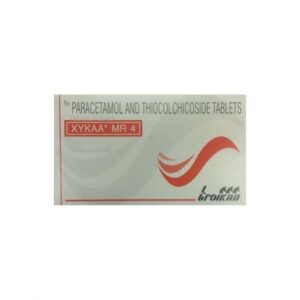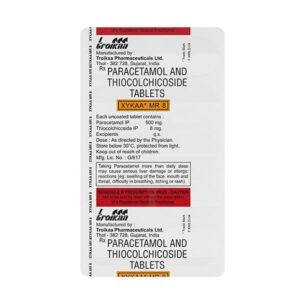PARACETAMOL (ACETAMENOPHEN) + THIOCOLCHICOSIDE
Paracetamol (acetamenophen): Paracetamol, also known as acetaminophen, is a commonly used medication for the treatment of pain and fever. It belongs to the class of drugs called analgesics (pain relievers) and antipyretics (fever reducers). Paracetamol is available over-the-counter and in prescription-strength formulations.
Paracetamol works by inhibiting the production of certain chemicals in the body called prostaglandins, which play a role in pain and fever. It is thought to work mainly in the central nervous system (CNS) and has little anti-inflammatory activity compared to nonsteroidal anti-inflammatory drugs (NSAIDs) like ibuprofen.
The recommended dose of paracetamol for adults is 325-650 mg every 4 to 6 hours, not exceeding 4,000 mg in 24 hours. The dose for children varies based on their weight and age.
Paracetamol is commonly used to relieve mild to moderate pain, such as headaches, toothaches, menstrual cramps, muscle aches, and backaches. It is also used to reduce fever associated with various conditions, including colds, flu, and infections.
While paracetamol is generally well-tolerated at recommended doses, it can cause side effects in some individuals. Common side effects include nausea, vomiting, upset stomach, and allergic reactions like skin rash or itching. In rare cases, it can cause serious liver damage, especially when taken in high doses or combined with excessive alcohol consumption.
It is important to follow the recommended dosing guidelines and avoid exceeding the maximum daily dose of paracetamol. Individuals with liver disease, those who consume alcohol heavily, or individuals taking other medications that can affect liver function should use paracetamol with caution and under medical supervision.
As with any medication, it is always advisable to consult a healthcare professional or read the product label for specific dosing instructions and to discuss any potential interactions or contraindications with other medications or medical conditions.
Thiocolchicoside: Thiocolchicoside is a muscle relaxant drug that is used to relieve muscle stiffness and spasms. It is commonly prescribed for conditions such as neck and back pain, muscle strains, and joint stiffness.
The mechanism of action of thiocolchicoside involves its binding to gamma-aminobutyric acid (GABA) receptors in the central nervous system. GABA is an inhibitory neurotransmitter that helps regulate the excitability of nerve cells. By binding to GABA receptors, thiocolchicoside enhances the inhibitory effects of GABA, resulting in muscle relaxation and relief from spasms and stiffness.
The usual recommended dose of thiocolchicoside is 8 to 16 mg per day, divided into two or three doses. However, the specific dosage may vary depending on the individual’s condition and the prescribing doctor’s instructions. It is important to follow the prescribed dosage and duration of treatment to achieve optimal results and minimize the risk of side effects.
Common side effects of thiocolchicoside may include drowsiness, dizziness, nausea, headache, and dry mouth. These side effects are generally mild and temporary, but if they persist or worsen, it is important to consult a healthcare professional. Some individuals may also experience allergic reactions, such as rash, itching, swelling, or difficulty breathing, which require immediate medical attention.
It is worth noting that thiocolchicoside is contraindicated in individuals with hypersensitivity to the drug or any of its components. It should also be used with caution in people with liver or kidney problems, as the drug is primarily metabolized in the liver and excreted through the kidneys.
As with any medication, it is essential to consult a healthcare professional before starting thiocolchicoside to ensure its safe and appropriate use, especially if there are any underlying medical conditions or concurrent medications.


